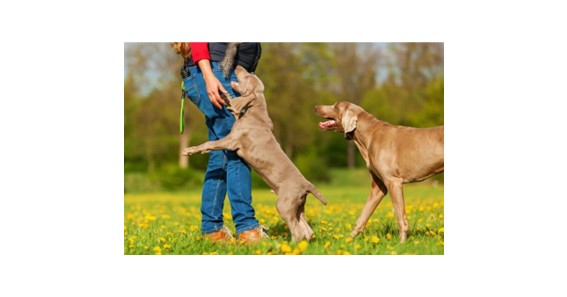Jumping on people is a behavior problem commonly exhibited by dogs, especially when they are excited or seeking attention. While it may seem harmless, jumping can be undesirable and even dangerous, particularly if the dog is large or the person being jumped on is vulnerable.
https://depositphotos.com/151800480/stock-photo-woman-plays-with-a-weimaraner.html
Reasons Why Dogs Jump on People
Dogs jumping on people can be a common behavior problem that many owners face. Understanding the reasons behind this behavior can help in effectively addressing and managing it. Here are some key reasons why dogs may jump on people:
Excitement and Exuberance:
Dogs may jump as a way to express their excitement and exuberance when they see their owners or visitors. It is their way of greeting and showing their enthusiasm. This behavior is more commonly seen in young and energetic dogs.
Attention-Seeking:
Dogs are social animals and often jump to get attention from their owners or other people around them. They learn that jumping results in attention, even if it’s negative attention. Dogs may jump to initiate play or to engage their owners in interaction.
Social Interaction:
Jumping on people can be a dog’s way of initiating social interaction. Some dogs may not have been taught appropriate greetings and may resort to jumping as a way to interact with people. They may jump as a means to establish connection and engage in play.
Dominance or Assertiveness:
In some cases, dogs may jump on people as a display of dominance or assertiveness. This behavior is often seen in dogs that have not received consistent training and boundaries. They may jump as a way to establish their position or assert control over a person or another animal.
Click Here – Hiring a Renowned Criminal Defence Attorney in Orangeville
Addressing and correcting jumping behavior:
Teach Appropriate Greetings:
Train your dog to greet people with all four paws on the ground. Use positive reinforcement techniques to reward calm and controlled behavior. Consistency is key in reinforcing the desired greeting behavior.
Ignore and Withdraw Attention:
When your dog jumps, avoid giving them attention, as any type of response can reinforce the behavior. Turn away, cross your arms, and refrain from eye contact. Wait for your dog to calm down and have all four paws on the ground before providing attention.
Redirect Behavior:
Teach your dog an alternative behavior to jumping, such as sitting or offering a paw. When your dog approaches you, ask for the alternative behavior and reward them for complying. Redirecting their attention and energy towards a more acceptable behavior can be effective.
Consistent Training:
Provide consistent training and establish clear boundaries for your dog. Teach them basic obedience commands, such as “sit” and “stay,” which can help in managing their behavior and providing them with guidance.
Reinforce Calm Behavior:
Reward your dog for calm and controlled behavior. When they approach you without jumping, provide verbal praise, petting, or treats as a positive reinforcement. This helps them learn that calm behavior is more rewarding than jumping.
Seek Professional Help:
If the jumping behavior persists or becomes problematic, consider seeking guidance from a professional board and train dog training dog trainer or animal behaviorist. They can assess the specific situation and provide tailored strategies to address the jumping behavior effectively.
Lots of Exercise:
The old cliché “a tired dog is a good dog” is often true. Dogs with lots of energy can act out and expend energy when greeting a human. A long walk is good for you and your dog. Use a dog walking service if you don’t have the time to walk.
Remember, patience, consistency, and positive reinforcement are essential in addressing jumping behavior. By teaching your dog appropriate greetings and reinforcing calm behavior, you can help them understand that jumping is not an acceptable way to interact with people.
Dog Jumping FAQs
FAQ: Why do dogs jump on people?
Answer: Dogs may jump on people for various reasons, including excitement, seeking attention, or as a form of greeting. It is a natural behavior for dogs to jump when they are happy or eager to interact.
FAQ: How can I prevent my dog from jumping on people?
Answer: To prevent your dog from jumping on people, you can employ several techniques. These include teaching them alternative greetings, rewarding calm behavior, and providing consistent training and redirection. It’s important to be consistent and reinforce appropriate behavior consistently.
FAQ: Is it okay to let my dog jump on people when they are excited?
Answer: While it may be tempting to allow your dog to jump on people when they are excited, it is generally not encouraged. Jumping can be seen as rude or even intimidating, especially for children or elderly individuals. It’s best to redirect their excitement into alternative behaviors.
FAQ: How can I train my dog not to jump on guests?
Answer: Training your dog not to jump on guests involves a combination of consistent training, positive reinforcement, and redirection. Teach your dog to sit or offer a calm behavior instead of jumping, and reward them for this behavior. Practice with friends or family members who can assist in the training process.
FAQ: What should I do if my dog jumps on people despite training efforts?
Answer: If your dog continues to jump on people despite training efforts, it may be necessary to reinforce training techniques and seek the guidance of a professional dog trainer or behaviorist. They can assess the specific behavior and provide additional strategies to address the jumping behavior effectively.
FAQ: Can jumping on people be a sign of aggression in dogs?
Answer: Jumping on people is typically not a sign of aggression in dogs. It is more commonly an expression of excitement, friendliness, or a desire for attention. However, it’s essential to monitor and evaluate your dog’s overall behavior and body language to ensure that jumping is not accompanied by aggressive tendencies.
